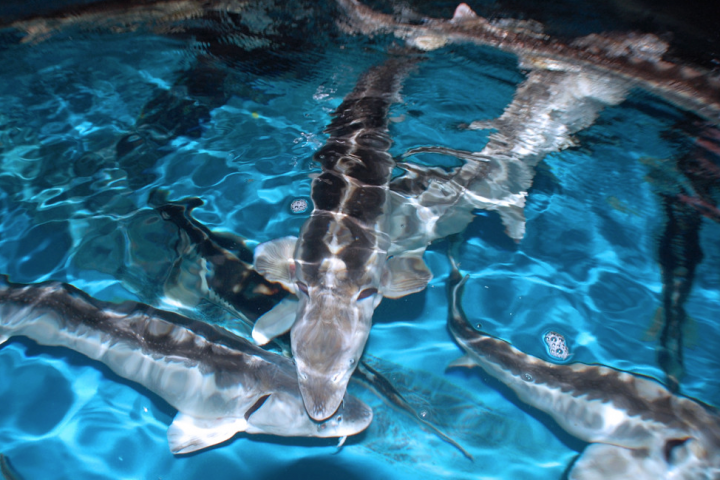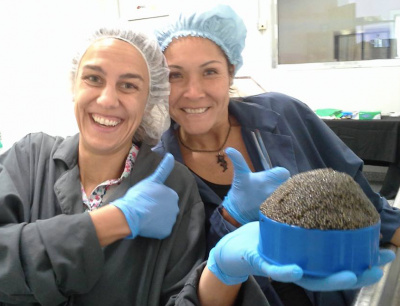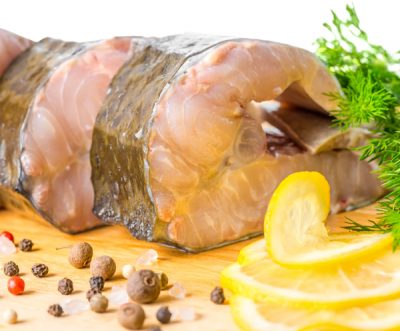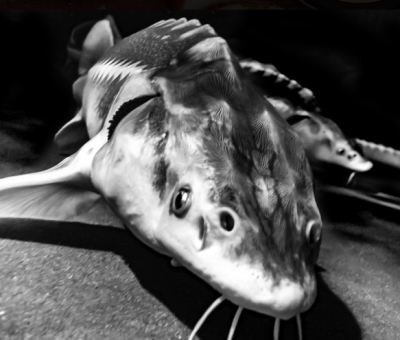
SMYRNA – Marshallberg Farm is nestled behind a wall of trees, off a side road in Down East Carteret County.
This isn’t your average eastern North Carolina farm. While there are a few chickens tucked away in a coop on the land, there’s no hog to be seen.
Supporter Spotlight
This is an aquaculture farm. There are around 40,000 Russian sturgeon — an endangered species — being raised sustainably in a recirculating aquaculture system, or RAS, for its meat and caviar, called osetra.
“The general idea is that the recirculating aquaculture system does not put out effluent, or pollution or anything,” said Lianne Won-Reburn, who handles sales and marketing for the farm, the largest producer of Russian sturgeon in the United States, according to their website.. “In America, there’s a lot of environmental standards that we by law have to follow.”
Brian Reburn, senior mechanic and Won-Reburn’s husband, broke down in simple terms how RAS works.
“In our farm, this means that we recycle the same water in the fish tanks over and over again. The water in the fish tanks drains into a cleaning filter then is pumped back into the tanks,” he said, adding that the water they use recycles about once every hour, all day, all year long. The small bit of water that is lost in the filtering process is replaced with fresh well water.

“Using RAS saves water and allows us to concentrate the fish waste into other forms we can use, like for gardening or growing koi fish in the ponds. We capture all of our waste products on site in ponds or outside fish waste tanks,” he said.
Supporter Spotlight
Reburn said that establishing a land-based fish farm has been a long and challenging process.
“We built the farm from the ground up, did most of our own plumbing, welding and electrical work,” he said, explaining that they started constructing the first fish tank building in 2010 and it took two years to complete.
“We moved in our first fish in the fall of 2011. There are 26 tanks with a total of about 500,000 gallons of water in them,” he said. The second building and processing took another two years. The building contains 16 tanks and another 500,000 gallons of water in RAS.
“We have had to learn how to do everything ourselves. Aquaculture in land-based tanks is a very new type of industry in the U.S. We are in the steam engine era of this industry,” he said. “While we do integrate sophisticated technology into how we raise fish, most things are done with manual labor and our brains. You can’t be shy about hard work and run a fish farm.”
Won-Reburn explained that her father, I.J. Won, a former geophysicist, started the farm about 10 years ago. They began selling sturgeon meat and caviar in September 2017.
“It’s a family farm, I work with my husband and dad,” she said, adding that her mother helps her with her kids. “It’s a great experience for us to work together.”
Russian sturgeon, which originated in the Caspian Sea, Won-Reburn explained, is a prehistoric fish that looks just as it did when dinosaurs were around. The fish is listed as endangered, and Won-Reburn said they were trying to figure out a way to provide Osetra caviar in a sustainable way that would counter poaching and the black market.
“This type of caviar is osetra, one step below beluga. It’s only farmed; you can’t get it in the wild,” Won-Reburn said.

Won-Reburn explained that there were several reasons why they chose to raise Russian sturgeon.
As far as aquaculture goes, she said, it’s expensive to run a recirculated aquaculture system. Raising something that has a high return is necessary to figure out of aquaculture is something that can be regularly done in the future.
Won-Reburn added that when they started the farm, they didn’t want to compete with local fishermen or with nearby communities.
Another reason they chose Russian sturgeon is that her father had a bigger picture. He wanted to use aquaculture as a means of farming in a sustainable way, because right now the U.S. imports almost all its seafood from other countries.
“So, his big vision was we need to figure out in this country how to use aquaculture in a clean way, sustainable way, and economically sound way,” she said.

When Won-Reburn’s father was researching how to start Marshallberg Farm, she said, he came across an operation now called Lapaz in the North Carolina mountains. He started talking with the designer and owner of that farm and through their talks, he learned his way around farming Russian sturgeon.
Lapaz, formerly known as Atlantic Caviar and Sturgeon, is an RAS sturgeon farm near Lenoir. Before Marshallberg Farm acquired Lapaz in June 2017, it had been owned and operated by North Carolina State University.
The first batch of fingerlings for Marshallberg Farm came from the Lapaz farm in 2011 and those fish now are approaching harvest time.
Won-Reburn said the meat sales are picking up in the U.S. A purveyor called Locals Seafood is now selling the meat, which has a texture similar to pork tenderloin or veail, at Farmers Markets in Chapel Hill, Morrisville and Raleigh. In Charlotte, there’s an international grocery store that sells the farm’s sturgeon meat every week. When the meat was introduced in the Charlotte grocery store, 300 pounds were gone in a few days.
Won-Reburn said a person in their 50 or 60s who grew up around the Caspian Sea can often be sentimental about the fish.
“They grew up before these fish were gone, before they were fished out, and they have memories of eating this fish by the sea on the grill,” she said. “They’ve been the most enthusiastic about the meat itself.”
For each ton of caviar there’s 10 tons of meat to sell, which is why they’re looking for bigger markets, too.
Recently, she said Ruddy Duck Tavern on the waterfront of Morehead City has been creating dishes with Russian sturgeon meat from the farm.
Regarding caviar, the restaurants in North Carolina are using it and there are customers buying online. A couple large distributors buy from the farm during the holiday season but they’re looking for more big distributors to pick up on it.
“You don’t want to harvest it unless you have a buyer,” she said. “We sell online little tins, but the bigger distributors determine when we harvest.”
Won-Reburn said they’re not in a hurry to harvest the fish. They’re giving the females the opportunity to grow while trying to find the bigger distributors.

“It takes seven years for them to produce roe for caviar,” she said.
The biggest challenge they’re facing, Won-Reburn explained, is that companies in China are farming sturgeons for caviar but they’re using pond aquaculture with no standards. “They’re selling their caviar to this country, mainly, and consumers are buying the Chinese caviar because it’s a lot cheaper.”
The other thing about caviar made in other countries is they use borax, an illegal preservative, Won-Reburn said. Marshallberg Farm doesn’t use any preservatives other than sea salt.
Russian sturgeons are overfished and it could be said that aquaculture is the only thing keeping the species alive, she added.
“They’re basically gone, they’re being poached for the caviar and by the time it gets anywhere to be sold, it’s not even in good condition anymore,” Won-Reburn said. And while there’s been restocking efforts in the Caspian Sea, there’s so many countries surrounding it, it’s difficult to be regulated.
She said she hopes aquaculture catches on in America, that consumers can tell a difference in quality and be willing to spend a little more for a product made responsibly.
“Aquaculture is possibly the way we are going to have seafood in the future,” she said.







